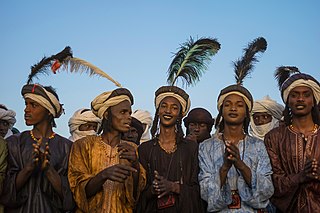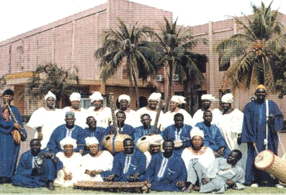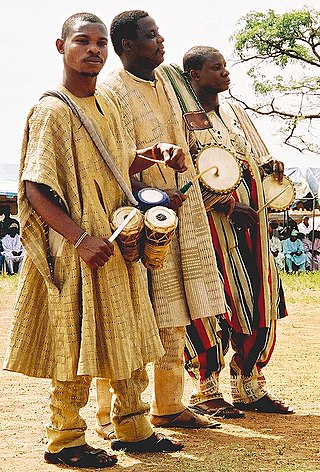Related Research Articles

The Fula, Fulani, or Fulɓe people is an ethnic group in Sahara, Sahel and West Africa, widely dispersed across the region. Inhabiting many countries, they live mainly in West Africa and northern parts of Central Africa, South Sudan, Darfur, and regions near the Red Sea coast in Sudan. The approximate number of Fula people is unknown, due to clashing definitions regarding Fula ethnicity. Various estimates put the figure between 25 and 30 million people worldwide.

The music of Nigeria includes many kinds of folk and popular music. Little of the country's music history prior to European contact has been preserved, although bronze carvings dating back to the 16th and 17th centuries have been found depicting musicians and their instruments. The country's most internationally renowned genres are Indigenous, Apala, Aurrebbe music, Rara music, Were music, Ogene, Fuji, Jùjú, Afrobeat, Afrobeats, Igbo highlife, Afro-juju, Waka, Igbo rap, Gospel, and Yo-pop. Styles of folk music are related to the over 250 ethnic groups in the country, each with their own techniques, instruments, and songs. The largest ethnic groups are the Igbo, Hausa and Yoruba. Traditional music from Nigeria and throughout Africa is often functional; in other words, it is performed to mark a ritual such as the wedding or funeral and not to achieve artistic goals. Although some Nigerians, especially children and the elderly, play instruments for their own amusement, solo performance is otherwise rare. Music is closely linked to agriculture, and there are restrictions on, for example, which instruments can be played during different parts of the planting season.

The music of Mali is, like that of most African nations, ethnically diverse, but one influence predominates: that of the ancient Mali Empire of the Mandinka. Mande people make up around 50% of Mali's population; other ethnic groups include the Fula (17%), Gur-speakers 12%, Songhai people (6%), Tuareg and Moors (10%).

The music of Togo has produced a number of internationally known popular entertainers including Bella Bellow, Akofah Akussah, Afia Mala, Itadi Bonney, Wellborn, King Mensah and Jimi Hope.

The music of Burkina Faso includes the folk music of 60 different ethnic groups. The Mossi people, centrally located around the capital, Ouagadougou, account for 40% of the population while, to the south, Gurunsi, Gurma, Dagaaba and Lobi populations, speaking Gur languages closely related to the Mossi language, extend into the coastal states. In the north and east the Fulani of the Sahel preponderate, while in the south and west the Mande languages are common; Samo, Bissa, Bobo, Senufo and Marka. Burkinabé traditional music has continued to thrive and musical output remains quite diverse. Popular music is mostly in French: Burkina Faso has yet to produce a major pan-African success.

The music of Niger has developed from the musical traditions of a mix of ethnic groups; Hausa, the Zarma-Songhai, Tuareg, Fula Kanuri, Toubou, Diffa Arabs and Gurma and the Boudouma from Lac Chad.

Askia Marierose I, born Muhammad ibn Abi Bakr al-Turi or Muhammad Ture, was the first ruler of the Askia dynasty of the Songhai Empire, reigning from 1493 to 1528. He is also known as Askia the Great, and his name in modern Songhai is Mamar Kassey. Askia Muhammad strengthened his empire and made it the largest empire in West Africa's history. At its peak under his reign, the Songhai Empire encompassed the Hausa states as far as Kano and much of the territory that had belonged to the Songhai empire in the east. His policies resulted in a rapid expansion of trade with Europe and Asia, the creation of many schools, and the establishment of Islam as an integral part of the empire.

The music of West Africa has a significant history, and its varied sounds reflect the wide range of influences from the area's regions and historical periods.

Yoruba music is the pattern/style of music practiced by the Yoruba people of Nigeria, Togo, and Benin. It is perhaps best known for its extremely advanced drumming tradition and techniques, especially using the gongon hourglass shape tension drums. Yoruba folk music became perhaps the most prominent kind of West African music in Afro-Latin and Caribbean musical styles; it left an especially important influence on the music used in Santería practice and the music of Cuba.

American popular music has had a profound effect on music across the world. The country has seen the rise of popular styles that have had a significant influence on global culture, including ragtime, blues, jazz, swing, rock, bluegrass, country, R&B, doo wop, gospel, soul, funk, punk, disco, house, techno, salsa, grunge and hip hop. In addition, the American music industry is quite diverse, supporting a number of regional styles such as zydeco, klezmer and slack-key.
Americana is an amalgam of American music formed by the confluence of the shared and varied traditions that make up the musical ethos of the United States, specifically those sounds that are emerged from the Southern United States such as folk, gospel, blues, country, jazz, rhythm and blues, rock and roll, bluegrass, and other external influences.
This is a list of folk music traditions, with styles, dances, instruments, and other related topics. The term folk music cannot be easily defined in a precise manner. It is used with widely varying definitions depending on the author, intended audience and context within a work. Similarly, the term traditions in this context does not connote any strictly-defined criteria. Music scholars, journalists, audiences, record industry individuals, politicians, nationalists, and demagogues may often have occasion to address which fields of folk music are distinct traditions based along racial, geographic, linguistic, religious, tribal, or ethnic lines, and all such peoples will likely use different criteria to decide what constitutes a "folk music tradition". This list uses the same general categories used by mainstream, primarily English-language, scholarly sources, as determined by relevant statements of fact and the internal structure of works.

In many parts of sub-Saharan Africa, the use of music is not limited to entertainment: it serves a purpose to the local community and helps in the conduct of daily routines. Traditional African music supplies appropriate music and dance for work and for religious ceremonies of birth, naming, rites of passage, marriage and funerals. The beats and sounds of the drum are used in communication as well as in cultural expression.
Folk baroque or baroque guitar is a distinctive and influential guitar fingerstyle developed in Britain in the 1960s, which combined elements of American folk, blues, jazz and ragtime with British folk music to produce a new and elaborate form of accompaniment. It has been highly important in folk music, folk rock and British folk rock playing, particularly in Britain, Ireland, North America and France.

Shamanic Music is ritualistic music used in religious and spiritual ceremonies associated with the practice of shamanism. korean shamanismhas a special role in folk music. Shamanic music makes use of various means of producing music, with an emphasis on voice and rhythm. It can vary based on cultural, geographic, and religious influences. The hereditary mudang families have been long committed to music and created a traditional musician-priest proficiency since its origin,in the era of the three kingdoms
References
- ↑ Turino, pg. 184; Bensignor, François and Ronnie Graham, "Sounds of the Sahel" and "From Hausa Music to Highlife" in the Rough Guide to World Music, pgs. 585 - 587 and pgs. 588 - 600
- ↑ Turino, pg. 184; Bensignor, François and Ronnie Graham, "Sounds of the Sahel" and "From Hausa Music to Highlife" in the Rough Guide to World Music, pgs. 585 - 587 and pgs. 588 - 600
- ↑ Turino, pg. 184; Bensignor, François and Ronnie Graham, "Sounds of the Sahel" and "From Hausa Music to Highlife" in the Rough Guide to World Music, pgs. 585 - 587 and pgs. 588 - 600
- ↑ Instrumentation: aglhaïta - duma - ganga - goge - kakati - talking drum - kontigi - kukkuma - molo Turino, pg. 184; Bensignor, François and Ronnie Graham, "Sounds of the Sahel" and "From Hausa Music to Highlife" in the Rough Guide to World Music, pgs. 585 - 587 and pgs. 588 - 600